Communication in Healthcare: Theories, Skills, Strategies Report
VerifiedAdded on 2020/04/29
|22
|5906
|121
Report
AI Summary
This report provides a comprehensive analysis of communication within healthcare and social care organizations, using a case study of a patient facing language barriers. It explores the application of communication theories, such as cognitive and behaviorist theories, and communication skills, including active listening and non-verbal communication, to improve patient-provider interactions. The report examines strategies to address inappropriate interpersonal communication, such as misinterpretation and breach of trust, and proposes solutions like using alternative languages and technological aids. It also discusses the impact of values, cultural factors, legislation, organizational policies, and ICT on communication effectiveness, offering recommendations for improvement and highlighting the importance of data protection. The report concludes by emphasizing the significance of effective communication for enhancing patient care and outcomes.
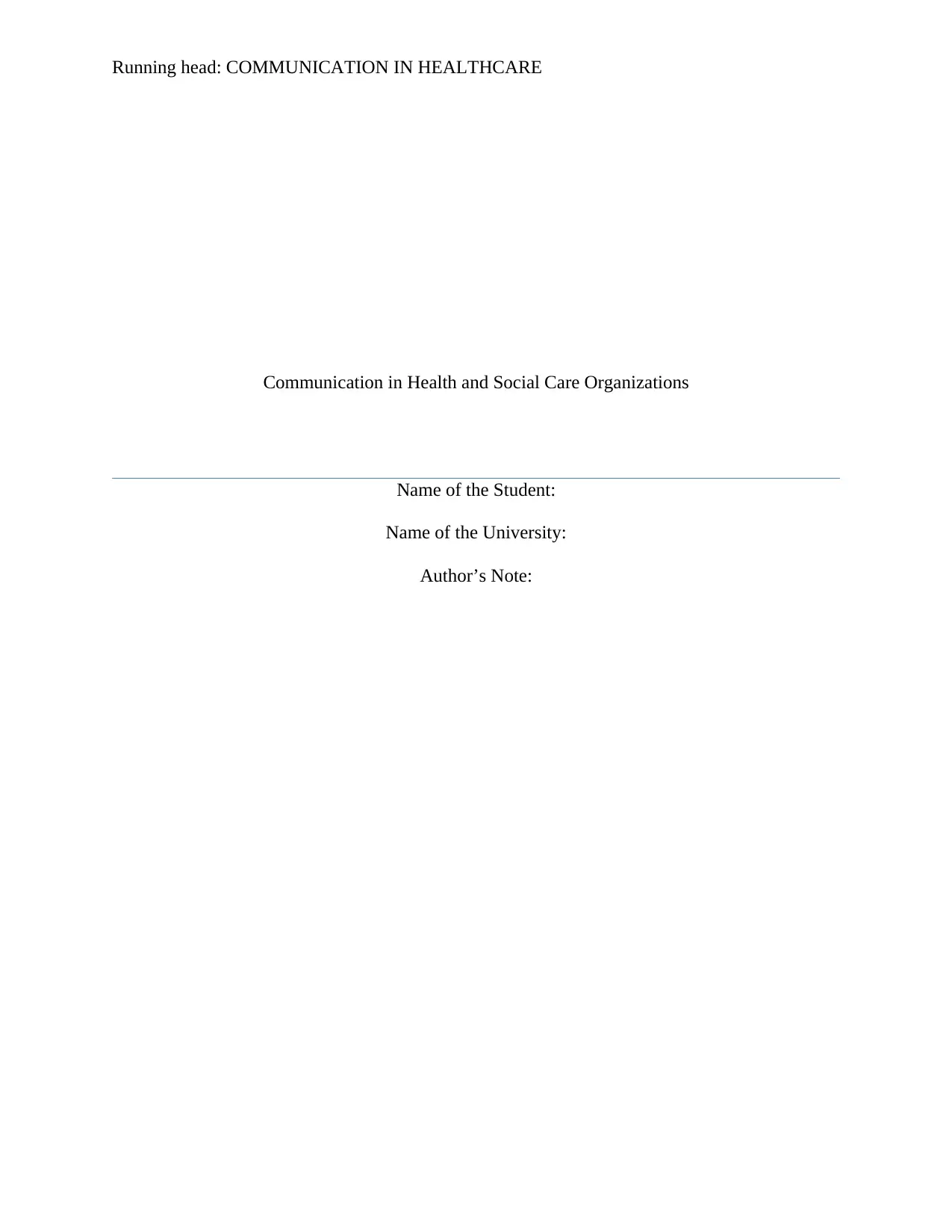
Running head: COMMUNICATION IN HEALTHCARE
Communication in Health and Social Care Organizations
Name of the Student:
Name of the University:
Author’s Note:
Communication in Health and Social Care Organizations
Name of the Student:
Name of the University:
Author’s Note:
Paraphrase This Document
Need a fresh take? Get an instant paraphrase of this document with our AI Paraphraser
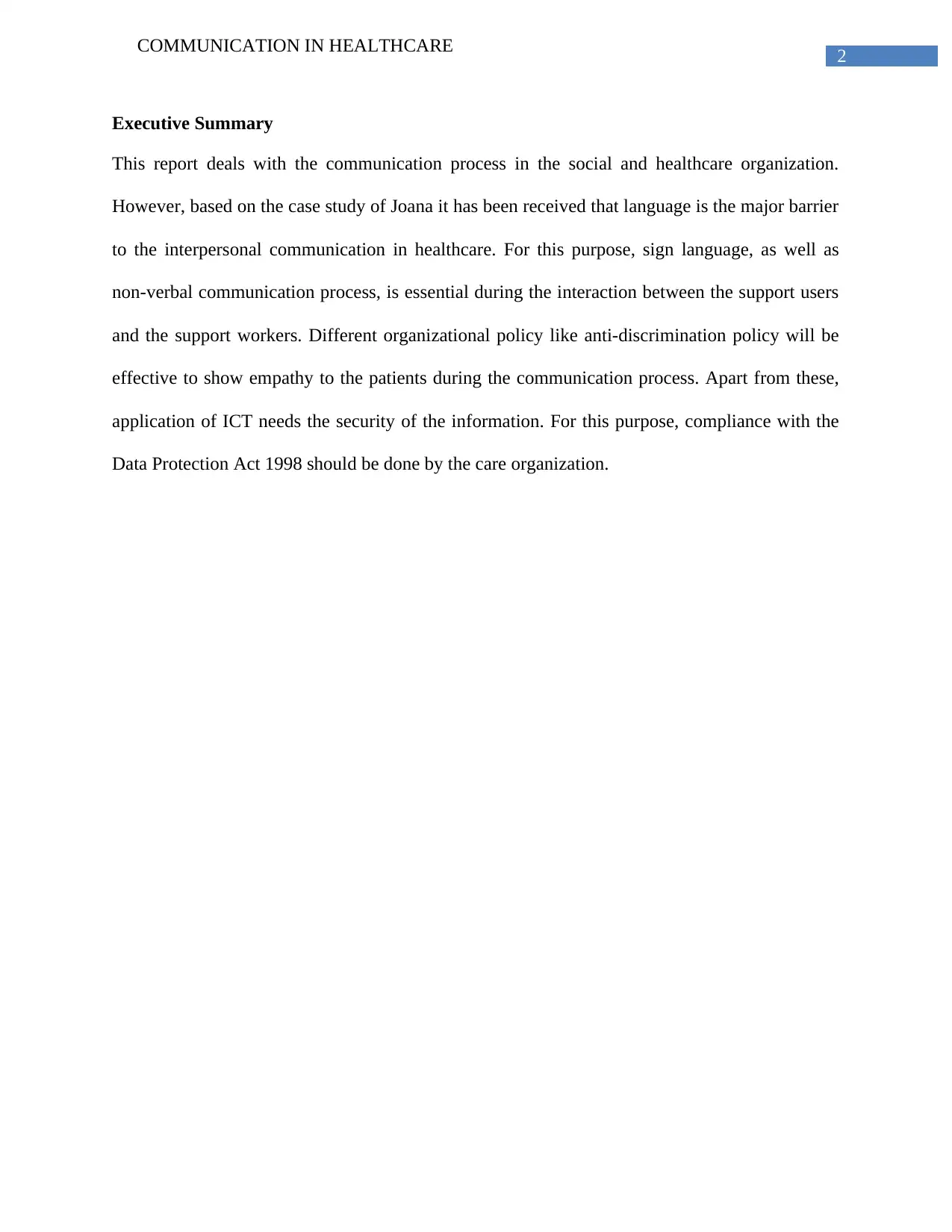
2
COMMUNICATION IN HEALTHCARE
Executive Summary
This report deals with the communication process in the social and healthcare organization.
However, based on the case study of Joana it has been received that language is the major barrier
to the interpersonal communication in healthcare. For this purpose, sign language, as well as
non-verbal communication process, is essential during the interaction between the support users
and the support workers. Different organizational policy like anti-discrimination policy will be
effective to show empathy to the patients during the communication process. Apart from these,
application of ICT needs the security of the information. For this purpose, compliance with the
Data Protection Act 1998 should be done by the care organization.
COMMUNICATION IN HEALTHCARE
Executive Summary
This report deals with the communication process in the social and healthcare organization.
However, based on the case study of Joana it has been received that language is the major barrier
to the interpersonal communication in healthcare. For this purpose, sign language, as well as
non-verbal communication process, is essential during the interaction between the support users
and the support workers. Different organizational policy like anti-discrimination policy will be
effective to show empathy to the patients during the communication process. Apart from these,
application of ICT needs the security of the information. For this purpose, compliance with the
Data Protection Act 1998 should be done by the care organization.
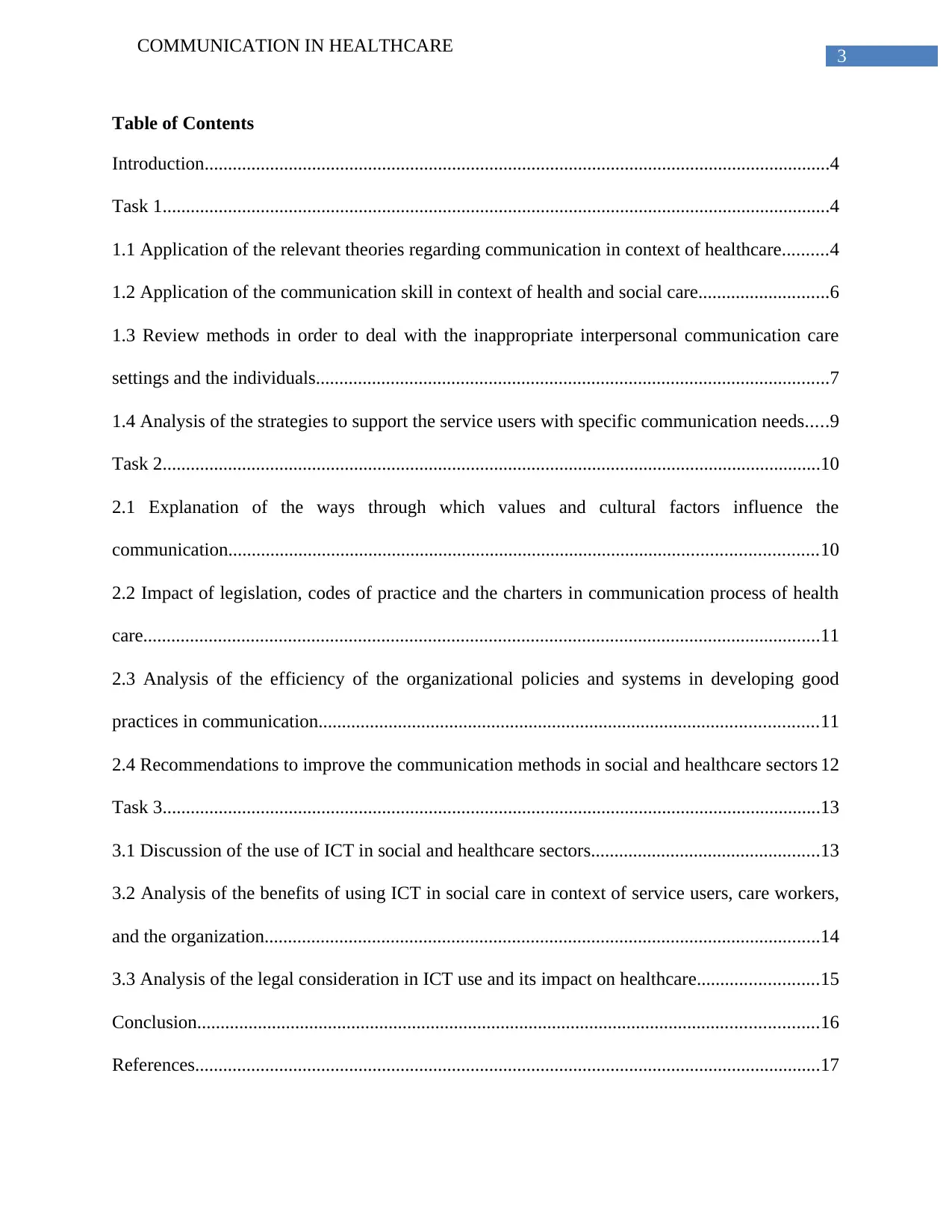
3
COMMUNICATION IN HEALTHCARE
Table of Contents
Introduction......................................................................................................................................4
Task 1...............................................................................................................................................4
1.1 Application of the relevant theories regarding communication in context of healthcare..........4
1.2 Application of the communication skill in context of health and social care............................6
1.3 Review methods in order to deal with the inappropriate interpersonal communication care
settings and the individuals..............................................................................................................7
1.4 Analysis of the strategies to support the service users with specific communication needs.....9
Task 2.............................................................................................................................................10
2.1 Explanation of the ways through which values and cultural factors influence the
communication..............................................................................................................................10
2.2 Impact of legislation, codes of practice and the charters in communication process of health
care.................................................................................................................................................11
2.3 Analysis of the efficiency of the organizational policies and systems in developing good
practices in communication...........................................................................................................11
2.4 Recommendations to improve the communication methods in social and healthcare sectors 12
Task 3.............................................................................................................................................13
3.1 Discussion of the use of ICT in social and healthcare sectors.................................................13
3.2 Analysis of the benefits of using ICT in social care in context of service users, care workers,
and the organization.......................................................................................................................14
3.3 Analysis of the legal consideration in ICT use and its impact on healthcare..........................15
Conclusion.....................................................................................................................................16
References......................................................................................................................................17
COMMUNICATION IN HEALTHCARE
Table of Contents
Introduction......................................................................................................................................4
Task 1...............................................................................................................................................4
1.1 Application of the relevant theories regarding communication in context of healthcare..........4
1.2 Application of the communication skill in context of health and social care............................6
1.3 Review methods in order to deal with the inappropriate interpersonal communication care
settings and the individuals..............................................................................................................7
1.4 Analysis of the strategies to support the service users with specific communication needs.....9
Task 2.............................................................................................................................................10
2.1 Explanation of the ways through which values and cultural factors influence the
communication..............................................................................................................................10
2.2 Impact of legislation, codes of practice and the charters in communication process of health
care.................................................................................................................................................11
2.3 Analysis of the efficiency of the organizational policies and systems in developing good
practices in communication...........................................................................................................11
2.4 Recommendations to improve the communication methods in social and healthcare sectors 12
Task 3.............................................................................................................................................13
3.1 Discussion of the use of ICT in social and healthcare sectors.................................................13
3.2 Analysis of the benefits of using ICT in social care in context of service users, care workers,
and the organization.......................................................................................................................14
3.3 Analysis of the legal consideration in ICT use and its impact on healthcare..........................15
Conclusion.....................................................................................................................................16
References......................................................................................................................................17
⊘ This is a preview!⊘
Do you want full access?
Subscribe today to unlock all pages.

Trusted by 1+ million students worldwide
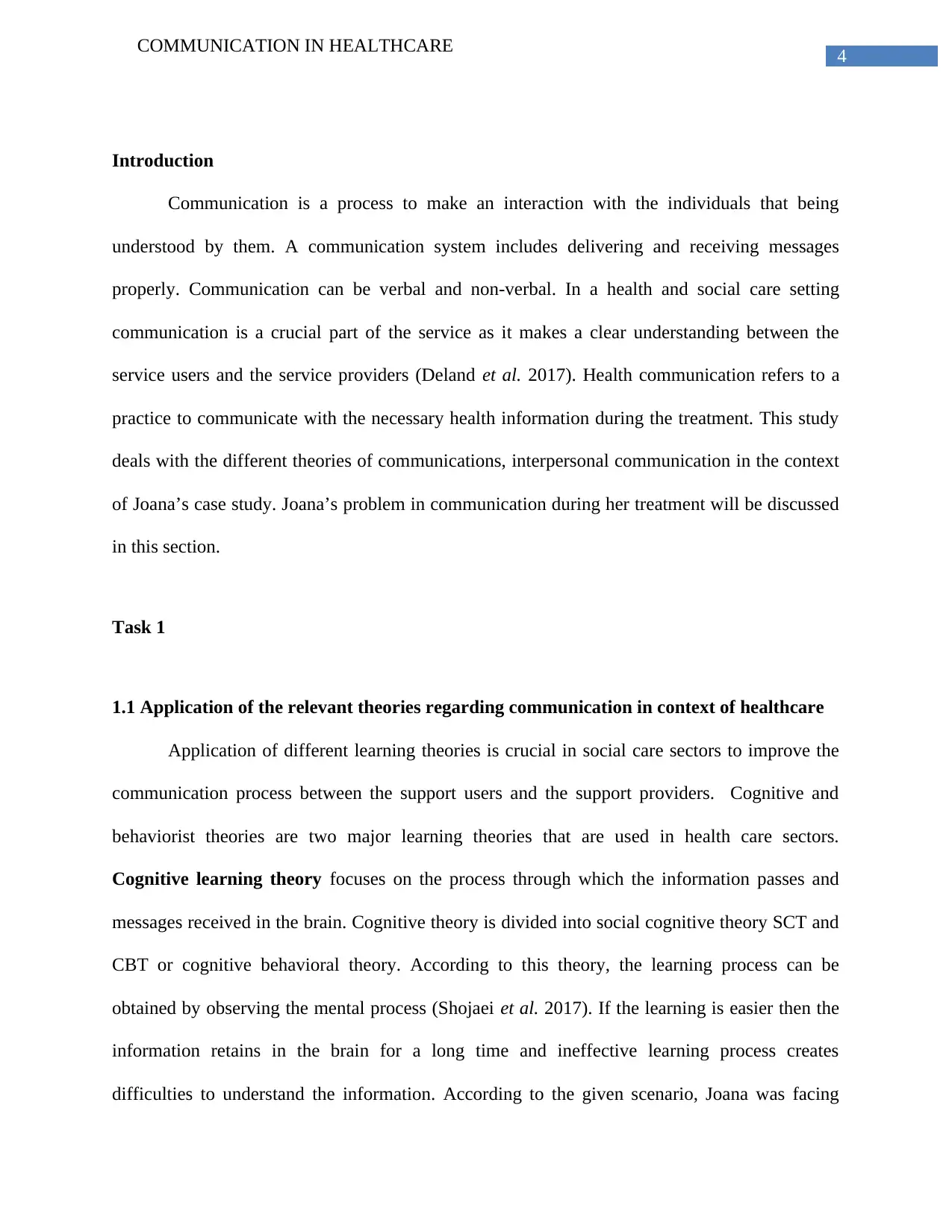
4
COMMUNICATION IN HEALTHCARE
Introduction
Communication is a process to make an interaction with the individuals that being
understood by them. A communication system includes delivering and receiving messages
properly. Communication can be verbal and non-verbal. In a health and social care setting
communication is a crucial part of the service as it makes a clear understanding between the
service users and the service providers (Deland et al. 2017). Health communication refers to a
practice to communicate with the necessary health information during the treatment. This study
deals with the different theories of communications, interpersonal communication in the context
of Joana’s case study. Joana’s problem in communication during her treatment will be discussed
in this section.
Task 1
1.1 Application of the relevant theories regarding communication in context of healthcare
Application of different learning theories is crucial in social care sectors to improve the
communication process between the support users and the support providers. Cognitive and
behaviorist theories are two major learning theories that are used in health care sectors.
Cognitive learning theory focuses on the process through which the information passes and
messages received in the brain. Cognitive theory is divided into social cognitive theory SCT and
CBT or cognitive behavioral theory. According to this theory, the learning process can be
obtained by observing the mental process (Shojaei et al. 2017). If the learning is easier then the
information retains in the brain for a long time and ineffective learning process creates
difficulties to understand the information. According to the given scenario, Joana was facing
COMMUNICATION IN HEALTHCARE
Introduction
Communication is a process to make an interaction with the individuals that being
understood by them. A communication system includes delivering and receiving messages
properly. Communication can be verbal and non-verbal. In a health and social care setting
communication is a crucial part of the service as it makes a clear understanding between the
service users and the service providers (Deland et al. 2017). Health communication refers to a
practice to communicate with the necessary health information during the treatment. This study
deals with the different theories of communications, interpersonal communication in the context
of Joana’s case study. Joana’s problem in communication during her treatment will be discussed
in this section.
Task 1
1.1 Application of the relevant theories regarding communication in context of healthcare
Application of different learning theories is crucial in social care sectors to improve the
communication process between the support users and the support providers. Cognitive and
behaviorist theories are two major learning theories that are used in health care sectors.
Cognitive learning theory focuses on the process through which the information passes and
messages received in the brain. Cognitive theory is divided into social cognitive theory SCT and
CBT or cognitive behavioral theory. According to this theory, the learning process can be
obtained by observing the mental process (Shojaei et al. 2017). If the learning is easier then the
information retains in the brain for a long time and ineffective learning process creates
difficulties to understand the information. According to the given scenario, Joana was facing
Paraphrase This Document
Need a fresh take? Get an instant paraphrase of this document with our AI Paraphraser
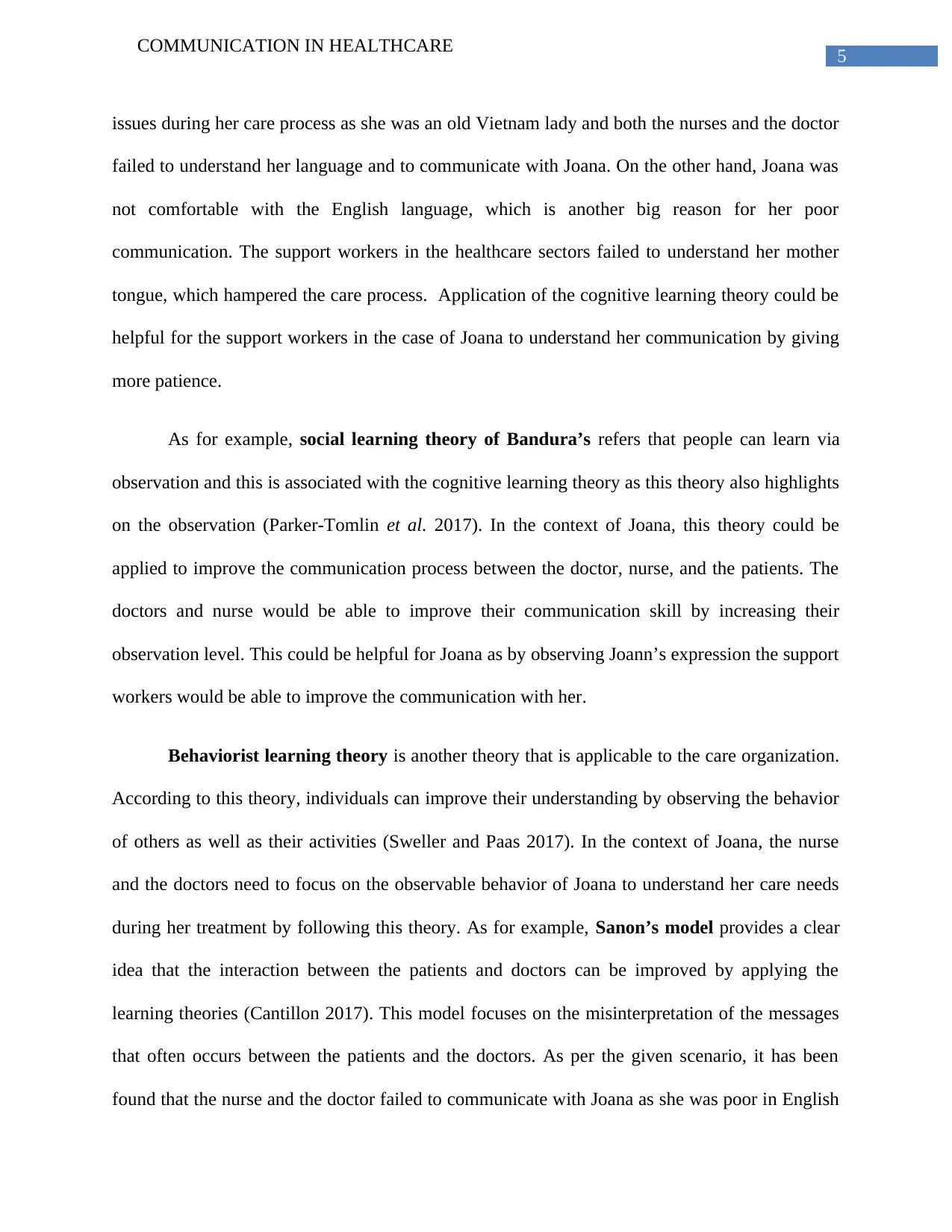
5
COMMUNICATION IN HEALTHCARE
issues during her care process as she was an old Vietnam lady and both the nurses and the doctor
failed to understand her language and to communicate with Joana. On the other hand, Joana was
not comfortable with the English language, which is another big reason for her poor
communication. The support workers in the healthcare sectors failed to understand her mother
tongue, which hampered the care process. Application of the cognitive learning theory could be
helpful for the support workers in the case of Joana to understand her communication by giving
more patience.
As for example, social learning theory of Bandura’s refers that people can learn via
observation and this is associated with the cognitive learning theory as this theory also highlights
on the observation (Parker-Tomlin et al. 2017). In the context of Joana, this theory could be
applied to improve the communication process between the doctor, nurse, and the patients. The
doctors and nurse would be able to improve their communication skill by increasing their
observation level. This could be helpful for Joana as by observing Joann’s expression the support
workers would be able to improve the communication with her.
Behaviorist learning theory is another theory that is applicable to the care organization.
According to this theory, individuals can improve their understanding by observing the behavior
of others as well as their activities (Sweller and Paas 2017). In the context of Joana, the nurse
and the doctors need to focus on the observable behavior of Joana to understand her care needs
during her treatment by following this theory. As for example, Sanon’s model provides a clear
idea that the interaction between the patients and doctors can be improved by applying the
learning theories (Cantillon 2017). This model focuses on the misinterpretation of the messages
that often occurs between the patients and the doctors. As per the given scenario, it has been
found that the nurse and the doctor failed to communicate with Joana as she was poor in English
COMMUNICATION IN HEALTHCARE
issues during her care process as she was an old Vietnam lady and both the nurses and the doctor
failed to understand her language and to communicate with Joana. On the other hand, Joana was
not comfortable with the English language, which is another big reason for her poor
communication. The support workers in the healthcare sectors failed to understand her mother
tongue, which hampered the care process. Application of the cognitive learning theory could be
helpful for the support workers in the case of Joana to understand her communication by giving
more patience.
As for example, social learning theory of Bandura’s refers that people can learn via
observation and this is associated with the cognitive learning theory as this theory also highlights
on the observation (Parker-Tomlin et al. 2017). In the context of Joana, this theory could be
applied to improve the communication process between the doctor, nurse, and the patients. The
doctors and nurse would be able to improve their communication skill by increasing their
observation level. This could be helpful for Joana as by observing Joann’s expression the support
workers would be able to improve the communication with her.
Behaviorist learning theory is another theory that is applicable to the care organization.
According to this theory, individuals can improve their understanding by observing the behavior
of others as well as their activities (Sweller and Paas 2017). In the context of Joana, the nurse
and the doctors need to focus on the observable behavior of Joana to understand her care needs
during her treatment by following this theory. As for example, Sanon’s model provides a clear
idea that the interaction between the patients and doctors can be improved by applying the
learning theories (Cantillon 2017). This model focuses on the misinterpretation of the messages
that often occurs between the patients and the doctors. As per the given scenario, it has been
found that the nurse and the doctor failed to communicate with Joana as she was poor in English
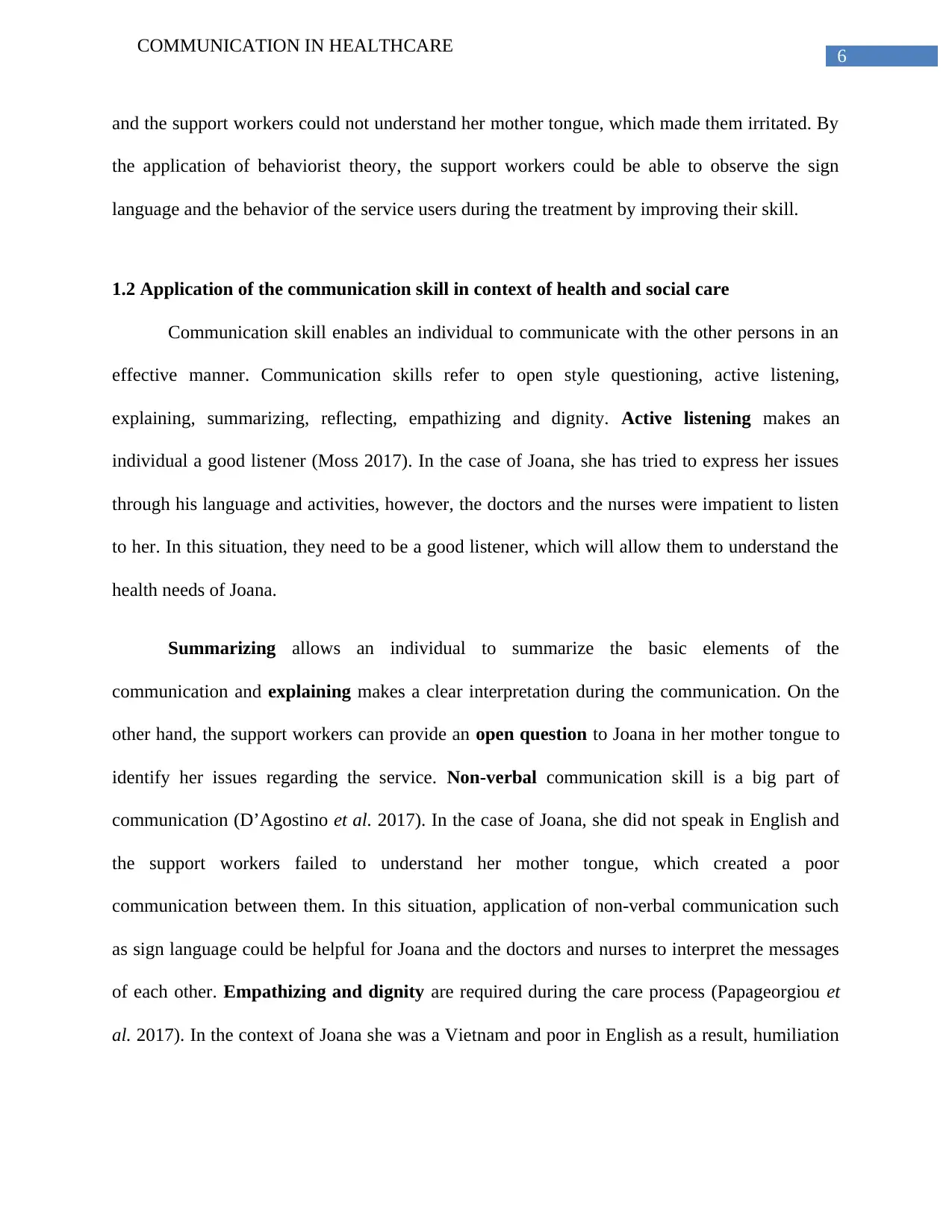
6
COMMUNICATION IN HEALTHCARE
and the support workers could not understand her mother tongue, which made them irritated. By
the application of behaviorist theory, the support workers could be able to observe the sign
language and the behavior of the service users during the treatment by improving their skill.
1.2 Application of the communication skill in context of health and social care
Communication skill enables an individual to communicate with the other persons in an
effective manner. Communication skills refer to open style questioning, active listening,
explaining, summarizing, reflecting, empathizing and dignity. Active listening makes an
individual a good listener (Moss 2017). In the case of Joana, she has tried to express her issues
through his language and activities, however, the doctors and the nurses were impatient to listen
to her. In this situation, they need to be a good listener, which will allow them to understand the
health needs of Joana.
Summarizing allows an individual to summarize the basic elements of the
communication and explaining makes a clear interpretation during the communication. On the
other hand, the support workers can provide an open question to Joana in her mother tongue to
identify her issues regarding the service. Non-verbal communication skill is a big part of
communication (D’Agostino et al. 2017). In the case of Joana, she did not speak in English and
the support workers failed to understand her mother tongue, which created a poor
communication between them. In this situation, application of non-verbal communication such
as sign language could be helpful for Joana and the doctors and nurses to interpret the messages
of each other. Empathizing and dignity are required during the care process (Papageorgiou et
al. 2017). In the context of Joana she was a Vietnam and poor in English as a result, humiliation
COMMUNICATION IN HEALTHCARE
and the support workers could not understand her mother tongue, which made them irritated. By
the application of behaviorist theory, the support workers could be able to observe the sign
language and the behavior of the service users during the treatment by improving their skill.
1.2 Application of the communication skill in context of health and social care
Communication skill enables an individual to communicate with the other persons in an
effective manner. Communication skills refer to open style questioning, active listening,
explaining, summarizing, reflecting, empathizing and dignity. Active listening makes an
individual a good listener (Moss 2017). In the case of Joana, she has tried to express her issues
through his language and activities, however, the doctors and the nurses were impatient to listen
to her. In this situation, they need to be a good listener, which will allow them to understand the
health needs of Joana.
Summarizing allows an individual to summarize the basic elements of the
communication and explaining makes a clear interpretation during the communication. On the
other hand, the support workers can provide an open question to Joana in her mother tongue to
identify her issues regarding the service. Non-verbal communication skill is a big part of
communication (D’Agostino et al. 2017). In the case of Joana, she did not speak in English and
the support workers failed to understand her mother tongue, which created a poor
communication between them. In this situation, application of non-verbal communication such
as sign language could be helpful for Joana and the doctors and nurses to interpret the messages
of each other. Empathizing and dignity are required during the care process (Papageorgiou et
al. 2017). In the context of Joana she was a Vietnam and poor in English as a result, humiliation
⊘ This is a preview!⊘
Do you want full access?
Subscribe today to unlock all pages.

Trusted by 1+ million students worldwide
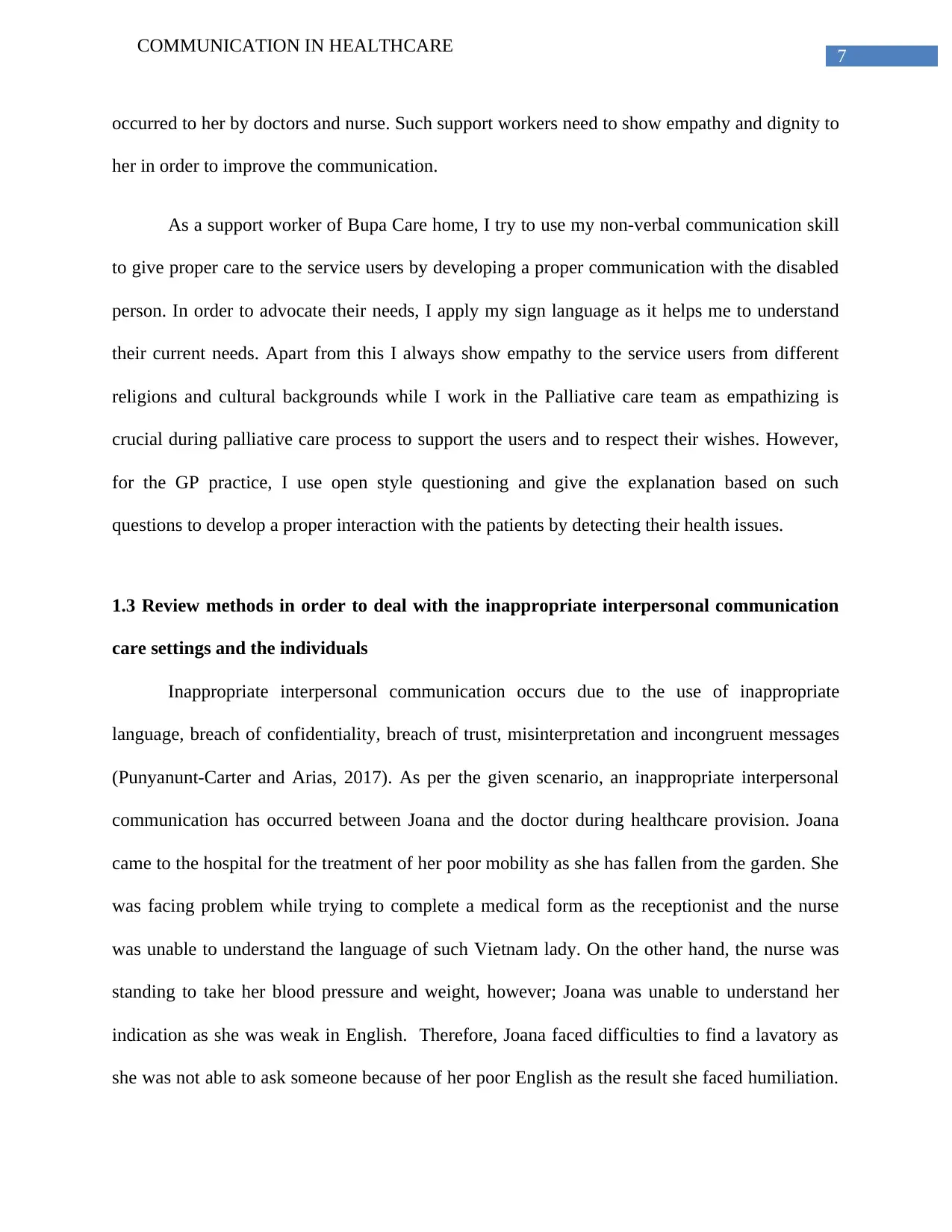
7
COMMUNICATION IN HEALTHCARE
occurred to her by doctors and nurse. Such support workers need to show empathy and dignity to
her in order to improve the communication.
As a support worker of Bupa Care home, I try to use my non-verbal communication skill
to give proper care to the service users by developing a proper communication with the disabled
person. In order to advocate their needs, I apply my sign language as it helps me to understand
their current needs. Apart from this I always show empathy to the service users from different
religions and cultural backgrounds while I work in the Palliative care team as empathizing is
crucial during palliative care process to support the users and to respect their wishes. However,
for the GP practice, I use open style questioning and give the explanation based on such
questions to develop a proper interaction with the patients by detecting their health issues.
1.3 Review methods in order to deal with the inappropriate interpersonal communication
care settings and the individuals
Inappropriate interpersonal communication occurs due to the use of inappropriate
language, breach of confidentiality, breach of trust, misinterpretation and incongruent messages
(Punyanunt-Carter and Arias, 2017). As per the given scenario, an inappropriate interpersonal
communication has occurred between Joana and the doctor during healthcare provision. Joana
came to the hospital for the treatment of her poor mobility as she has fallen from the garden. She
was facing problem while trying to complete a medical form as the receptionist and the nurse
was unable to understand the language of such Vietnam lady. On the other hand, the nurse was
standing to take her blood pressure and weight, however; Joana was unable to understand her
indication as she was weak in English. Therefore, Joana faced difficulties to find a lavatory as
she was not able to ask someone because of her poor English as the result she faced humiliation.
COMMUNICATION IN HEALTHCARE
occurred to her by doctors and nurse. Such support workers need to show empathy and dignity to
her in order to improve the communication.
As a support worker of Bupa Care home, I try to use my non-verbal communication skill
to give proper care to the service users by developing a proper communication with the disabled
person. In order to advocate their needs, I apply my sign language as it helps me to understand
their current needs. Apart from this I always show empathy to the service users from different
religions and cultural backgrounds while I work in the Palliative care team as empathizing is
crucial during palliative care process to support the users and to respect their wishes. However,
for the GP practice, I use open style questioning and give the explanation based on such
questions to develop a proper interaction with the patients by detecting their health issues.
1.3 Review methods in order to deal with the inappropriate interpersonal communication
care settings and the individuals
Inappropriate interpersonal communication occurs due to the use of inappropriate
language, breach of confidentiality, breach of trust, misinterpretation and incongruent messages
(Punyanunt-Carter and Arias, 2017). As per the given scenario, an inappropriate interpersonal
communication has occurred between Joana and the doctor during healthcare provision. Joana
came to the hospital for the treatment of her poor mobility as she has fallen from the garden. She
was facing problem while trying to complete a medical form as the receptionist and the nurse
was unable to understand the language of such Vietnam lady. On the other hand, the nurse was
standing to take her blood pressure and weight, however; Joana was unable to understand her
indication as she was weak in English. Therefore, Joana faced difficulties to find a lavatory as
she was not able to ask someone because of her poor English as the result she faced humiliation.
Paraphrase This Document
Need a fresh take? Get an instant paraphrase of this document with our AI Paraphraser
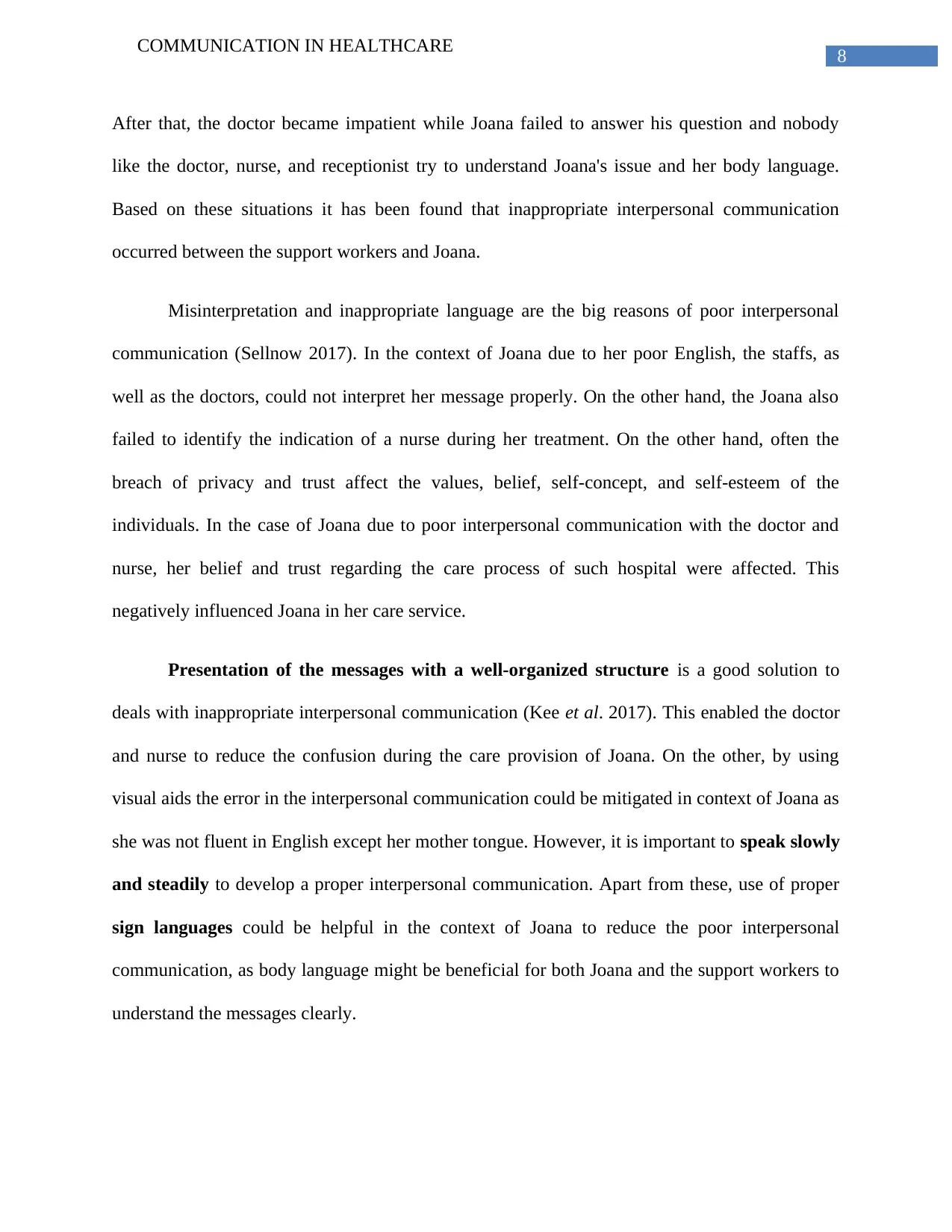
8
COMMUNICATION IN HEALTHCARE
After that, the doctor became impatient while Joana failed to answer his question and nobody
like the doctor, nurse, and receptionist try to understand Joana's issue and her body language.
Based on these situations it has been found that inappropriate interpersonal communication
occurred between the support workers and Joana.
Misinterpretation and inappropriate language are the big reasons of poor interpersonal
communication (Sellnow 2017). In the context of Joana due to her poor English, the staffs, as
well as the doctors, could not interpret her message properly. On the other hand, the Joana also
failed to identify the indication of a nurse during her treatment. On the other hand, often the
breach of privacy and trust affect the values, belief, self-concept, and self-esteem of the
individuals. In the case of Joana due to poor interpersonal communication with the doctor and
nurse, her belief and trust regarding the care process of such hospital were affected. This
negatively influenced Joana in her care service.
Presentation of the messages with a well-organized structure is a good solution to
deals with inappropriate interpersonal communication (Kee et al. 2017). This enabled the doctor
and nurse to reduce the confusion during the care provision of Joana. On the other, by using
visual aids the error in the interpersonal communication could be mitigated in context of Joana as
she was not fluent in English except her mother tongue. However, it is important to speak slowly
and steadily to develop a proper interpersonal communication. Apart from these, use of proper
sign languages could be helpful in the context of Joana to reduce the poor interpersonal
communication, as body language might be beneficial for both Joana and the support workers to
understand the messages clearly.
COMMUNICATION IN HEALTHCARE
After that, the doctor became impatient while Joana failed to answer his question and nobody
like the doctor, nurse, and receptionist try to understand Joana's issue and her body language.
Based on these situations it has been found that inappropriate interpersonal communication
occurred between the support workers and Joana.
Misinterpretation and inappropriate language are the big reasons of poor interpersonal
communication (Sellnow 2017). In the context of Joana due to her poor English, the staffs, as
well as the doctors, could not interpret her message properly. On the other hand, the Joana also
failed to identify the indication of a nurse during her treatment. On the other hand, often the
breach of privacy and trust affect the values, belief, self-concept, and self-esteem of the
individuals. In the case of Joana due to poor interpersonal communication with the doctor and
nurse, her belief and trust regarding the care process of such hospital were affected. This
negatively influenced Joana in her care service.
Presentation of the messages with a well-organized structure is a good solution to
deals with inappropriate interpersonal communication (Kee et al. 2017). This enabled the doctor
and nurse to reduce the confusion during the care provision of Joana. On the other, by using
visual aids the error in the interpersonal communication could be mitigated in context of Joana as
she was not fluent in English except her mother tongue. However, it is important to speak slowly
and steadily to develop a proper interpersonal communication. Apart from these, use of proper
sign languages could be helpful in the context of Joana to reduce the poor interpersonal
communication, as body language might be beneficial for both Joana and the support workers to
understand the messages clearly.
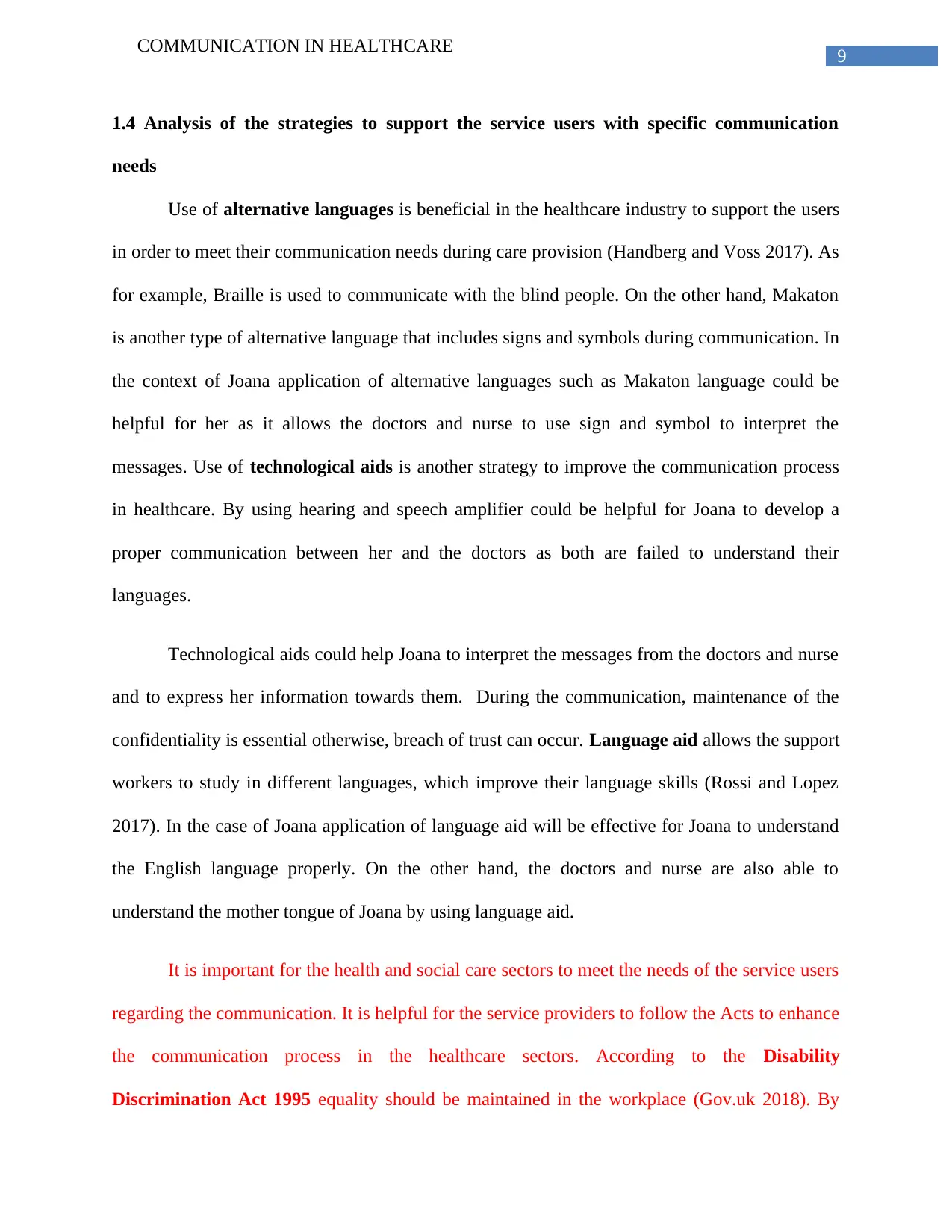
9
COMMUNICATION IN HEALTHCARE
1.4 Analysis of the strategies to support the service users with specific communication
needs
Use of alternative languages is beneficial in the healthcare industry to support the users
in order to meet their communication needs during care provision (Handberg and Voss 2017). As
for example, Braille is used to communicate with the blind people. On the other hand, Makaton
is another type of alternative language that includes signs and symbols during communication. In
the context of Joana application of alternative languages such as Makaton language could be
helpful for her as it allows the doctors and nurse to use sign and symbol to interpret the
messages. Use of technological aids is another strategy to improve the communication process
in healthcare. By using hearing and speech amplifier could be helpful for Joana to develop a
proper communication between her and the doctors as both are failed to understand their
languages.
Technological aids could help Joana to interpret the messages from the doctors and nurse
and to express her information towards them. During the communication, maintenance of the
confidentiality is essential otherwise, breach of trust can occur. Language aid allows the support
workers to study in different languages, which improve their language skills (Rossi and Lopez
2017). In the case of Joana application of language aid will be effective for Joana to understand
the English language properly. On the other hand, the doctors and nurse are also able to
understand the mother tongue of Joana by using language aid.
It is important for the health and social care sectors to meet the needs of the service users
regarding the communication. It is helpful for the service providers to follow the Acts to enhance
the communication process in the healthcare sectors. According to the Disability
Discrimination Act 1995 equality should be maintained in the workplace (Gov.uk 2018). By
COMMUNICATION IN HEALTHCARE
1.4 Analysis of the strategies to support the service users with specific communication
needs
Use of alternative languages is beneficial in the healthcare industry to support the users
in order to meet their communication needs during care provision (Handberg and Voss 2017). As
for example, Braille is used to communicate with the blind people. On the other hand, Makaton
is another type of alternative language that includes signs and symbols during communication. In
the context of Joana application of alternative languages such as Makaton language could be
helpful for her as it allows the doctors and nurse to use sign and symbol to interpret the
messages. Use of technological aids is another strategy to improve the communication process
in healthcare. By using hearing and speech amplifier could be helpful for Joana to develop a
proper communication between her and the doctors as both are failed to understand their
languages.
Technological aids could help Joana to interpret the messages from the doctors and nurse
and to express her information towards them. During the communication, maintenance of the
confidentiality is essential otherwise, breach of trust can occur. Language aid allows the support
workers to study in different languages, which improve their language skills (Rossi and Lopez
2017). In the case of Joana application of language aid will be effective for Joana to understand
the English language properly. On the other hand, the doctors and nurse are also able to
understand the mother tongue of Joana by using language aid.
It is important for the health and social care sectors to meet the needs of the service users
regarding the communication. It is helpful for the service providers to follow the Acts to enhance
the communication process in the healthcare sectors. According to the Disability
Discrimination Act 1995 equality should be maintained in the workplace (Gov.uk 2018). By
⊘ This is a preview!⊘
Do you want full access?
Subscribe today to unlock all pages.

Trusted by 1+ million students worldwide
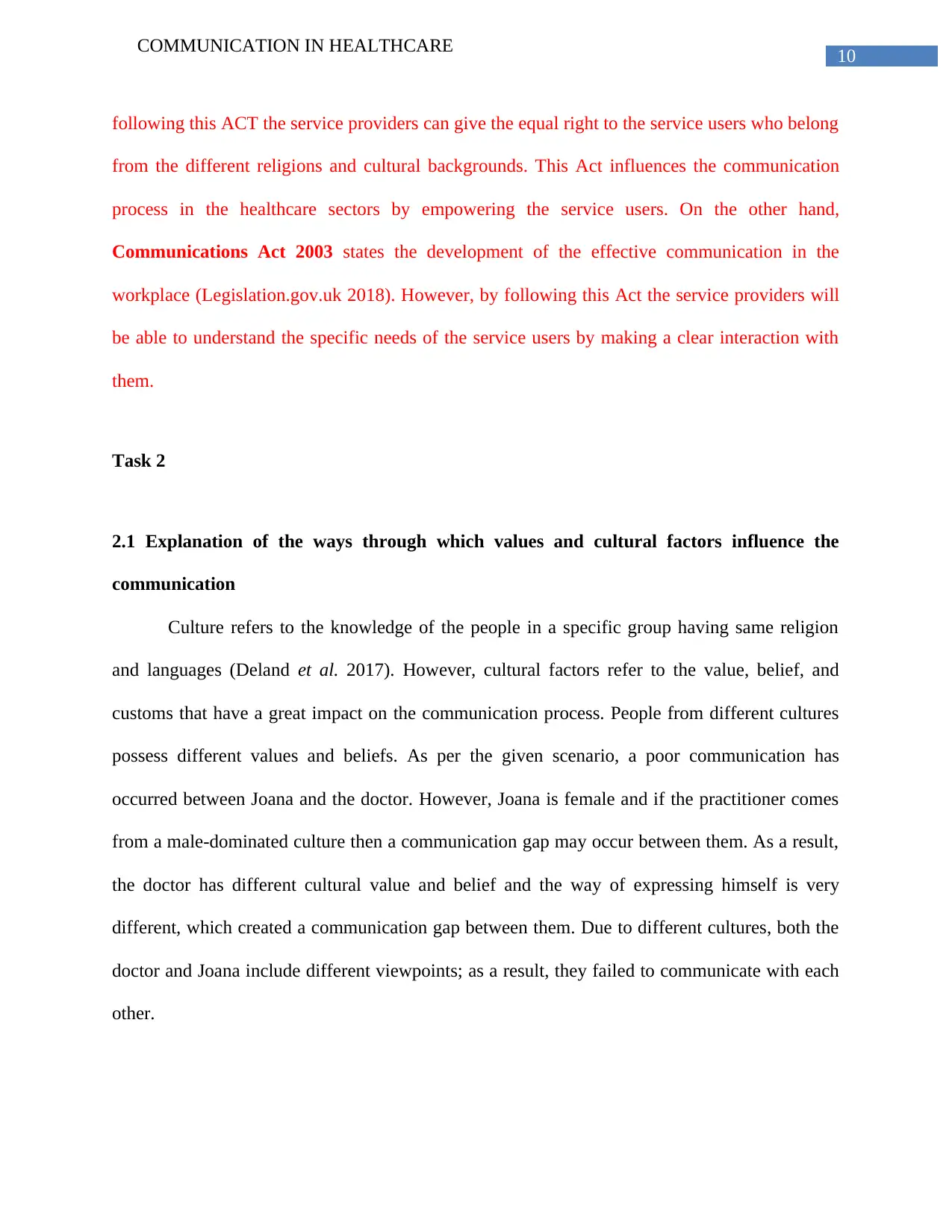
10
COMMUNICATION IN HEALTHCARE
following this ACT the service providers can give the equal right to the service users who belong
from the different religions and cultural backgrounds. This Act influences the communication
process in the healthcare sectors by empowering the service users. On the other hand,
Communications Act 2003 states the development of the effective communication in the
workplace (Legislation.gov.uk 2018). However, by following this Act the service providers will
be able to understand the specific needs of the service users by making a clear interaction with
them.
Task 2
2.1 Explanation of the ways through which values and cultural factors influence the
communication
Culture refers to the knowledge of the people in a specific group having same religion
and languages (Deland et al. 2017). However, cultural factors refer to the value, belief, and
customs that have a great impact on the communication process. People from different cultures
possess different values and beliefs. As per the given scenario, a poor communication has
occurred between Joana and the doctor. However, Joana is female and if the practitioner comes
from a male-dominated culture then a communication gap may occur between them. As a result,
the doctor has different cultural value and belief and the way of expressing himself is very
different, which created a communication gap between them. Due to different cultures, both the
doctor and Joana include different viewpoints; as a result, they failed to communicate with each
other.
COMMUNICATION IN HEALTHCARE
following this ACT the service providers can give the equal right to the service users who belong
from the different religions and cultural backgrounds. This Act influences the communication
process in the healthcare sectors by empowering the service users. On the other hand,
Communications Act 2003 states the development of the effective communication in the
workplace (Legislation.gov.uk 2018). However, by following this Act the service providers will
be able to understand the specific needs of the service users by making a clear interaction with
them.
Task 2
2.1 Explanation of the ways through which values and cultural factors influence the
communication
Culture refers to the knowledge of the people in a specific group having same religion
and languages (Deland et al. 2017). However, cultural factors refer to the value, belief, and
customs that have a great impact on the communication process. People from different cultures
possess different values and beliefs. As per the given scenario, a poor communication has
occurred between Joana and the doctor. However, Joana is female and if the practitioner comes
from a male-dominated culture then a communication gap may occur between them. As a result,
the doctor has different cultural value and belief and the way of expressing himself is very
different, which created a communication gap between them. Due to different cultures, both the
doctor and Joana include different viewpoints; as a result, they failed to communicate with each
other.
Paraphrase This Document
Need a fresh take? Get an instant paraphrase of this document with our AI Paraphraser
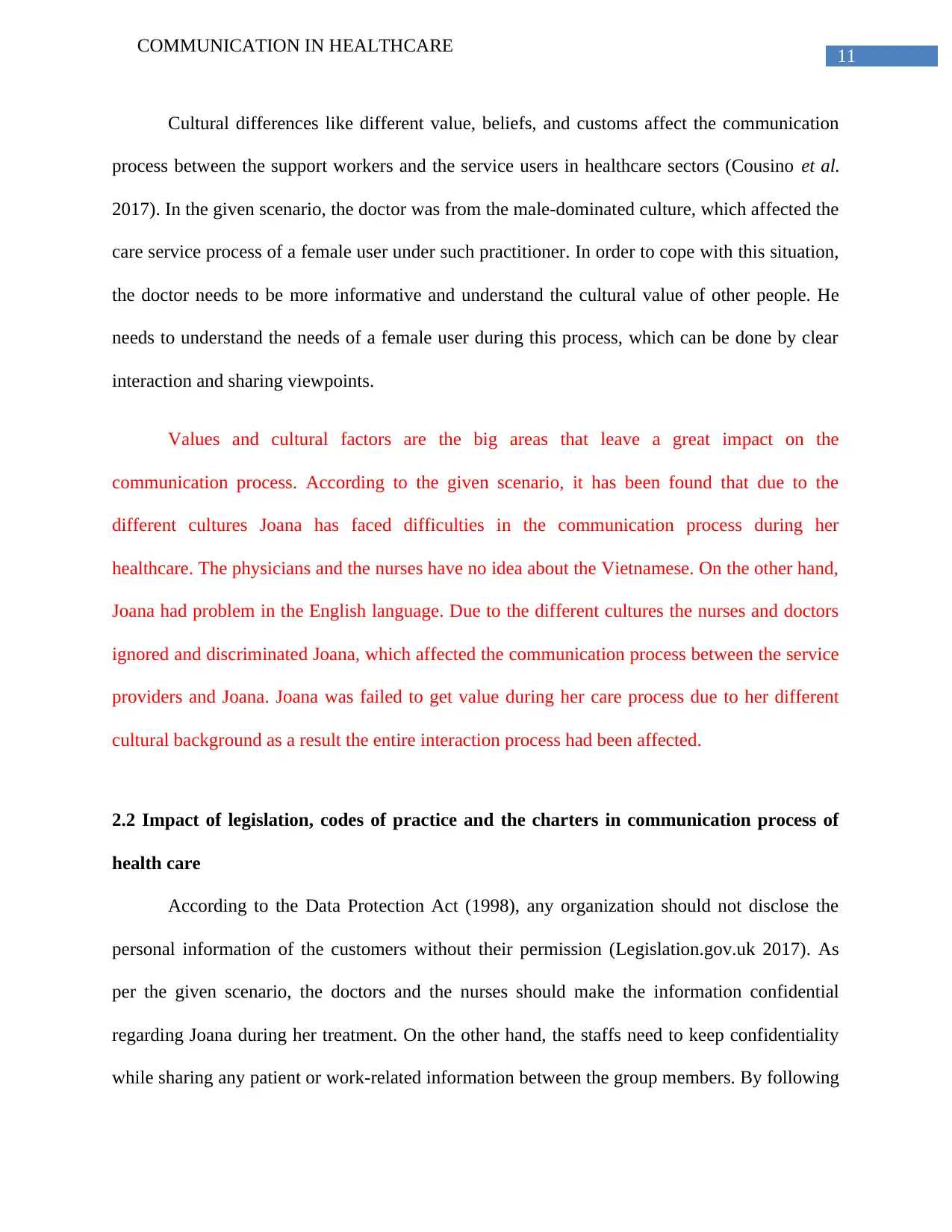
11
COMMUNICATION IN HEALTHCARE
Cultural differences like different value, beliefs, and customs affect the communication
process between the support workers and the service users in healthcare sectors (Cousino et al.
2017). In the given scenario, the doctor was from the male-dominated culture, which affected the
care service process of a female user under such practitioner. In order to cope with this situation,
the doctor needs to be more informative and understand the cultural value of other people. He
needs to understand the needs of a female user during this process, which can be done by clear
interaction and sharing viewpoints.
Values and cultural factors are the big areas that leave a great impact on the
communication process. According to the given scenario, it has been found that due to the
different cultures Joana has faced difficulties in the communication process during her
healthcare. The physicians and the nurses have no idea about the Vietnamese. On the other hand,
Joana had problem in the English language. Due to the different cultures the nurses and doctors
ignored and discriminated Joana, which affected the communication process between the service
providers and Joana. Joana was failed to get value during her care process due to her different
cultural background as a result the entire interaction process had been affected.
2.2 Impact of legislation, codes of practice and the charters in communication process of
health care
According to the Data Protection Act (1998), any organization should not disclose the
personal information of the customers without their permission (Legislation.gov.uk 2017). As
per the given scenario, the doctors and the nurses should make the information confidential
regarding Joana during her treatment. On the other hand, the staffs need to keep confidentiality
while sharing any patient or work-related information between the group members. By following
COMMUNICATION IN HEALTHCARE
Cultural differences like different value, beliefs, and customs affect the communication
process between the support workers and the service users in healthcare sectors (Cousino et al.
2017). In the given scenario, the doctor was from the male-dominated culture, which affected the
care service process of a female user under such practitioner. In order to cope with this situation,
the doctor needs to be more informative and understand the cultural value of other people. He
needs to understand the needs of a female user during this process, which can be done by clear
interaction and sharing viewpoints.
Values and cultural factors are the big areas that leave a great impact on the
communication process. According to the given scenario, it has been found that due to the
different cultures Joana has faced difficulties in the communication process during her
healthcare. The physicians and the nurses have no idea about the Vietnamese. On the other hand,
Joana had problem in the English language. Due to the different cultures the nurses and doctors
ignored and discriminated Joana, which affected the communication process between the service
providers and Joana. Joana was failed to get value during her care process due to her different
cultural background as a result the entire interaction process had been affected.
2.2 Impact of legislation, codes of practice and the charters in communication process of
health care
According to the Data Protection Act (1998), any organization should not disclose the
personal information of the customers without their permission (Legislation.gov.uk 2017). As
per the given scenario, the doctors and the nurses should make the information confidential
regarding Joana during her treatment. On the other hand, the staffs need to keep confidentiality
while sharing any patient or work-related information between the group members. By following
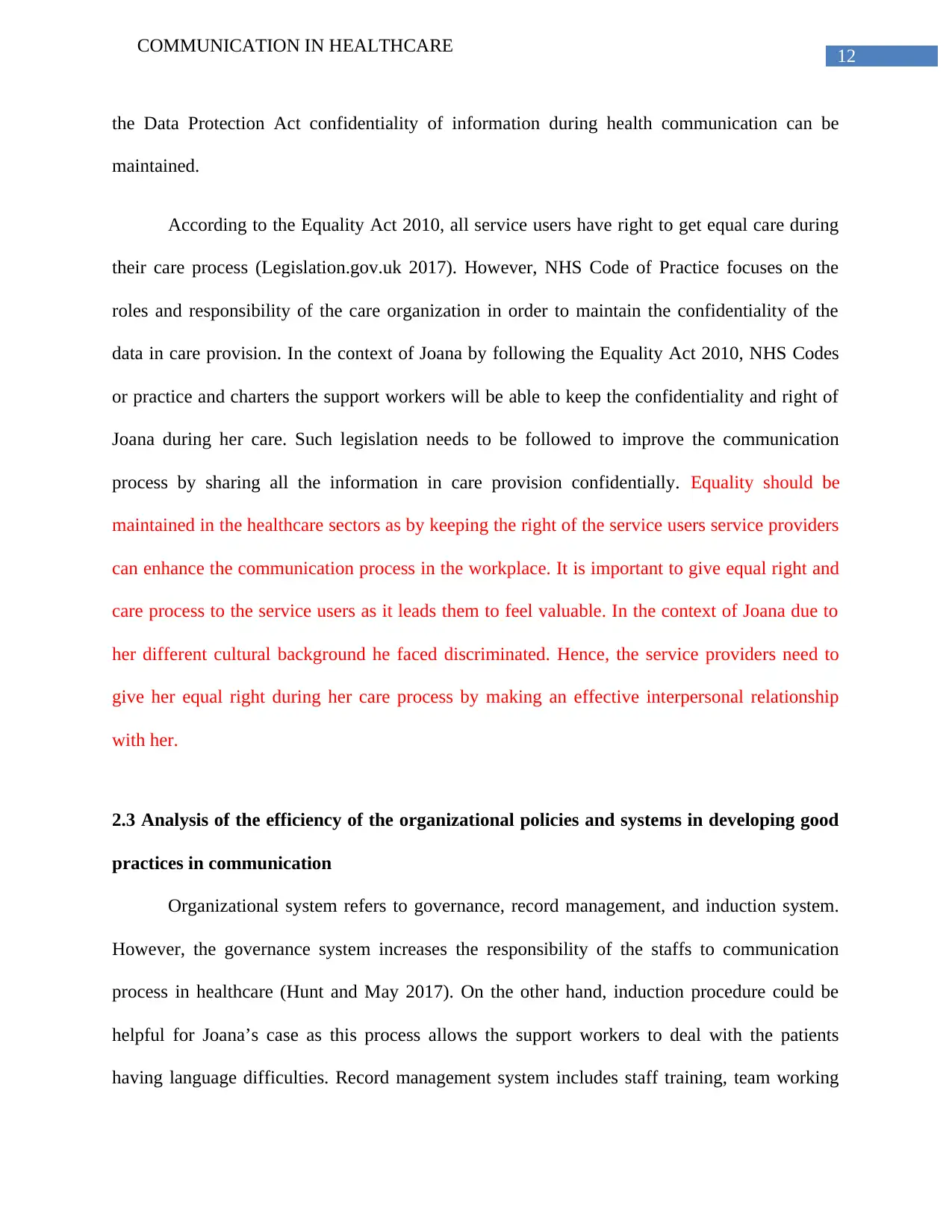
12
COMMUNICATION IN HEALTHCARE
the Data Protection Act confidentiality of information during health communication can be
maintained.
According to the Equality Act 2010, all service users have right to get equal care during
their care process (Legislation.gov.uk 2017). However, NHS Code of Practice focuses on the
roles and responsibility of the care organization in order to maintain the confidentiality of the
data in care provision. In the context of Joana by following the Equality Act 2010, NHS Codes
or practice and charters the support workers will be able to keep the confidentiality and right of
Joana during her care. Such legislation needs to be followed to improve the communication
process by sharing all the information in care provision confidentially. Equality should be
maintained in the healthcare sectors as by keeping the right of the service users service providers
can enhance the communication process in the workplace. It is important to give equal right and
care process to the service users as it leads them to feel valuable. In the context of Joana due to
her different cultural background he faced discriminated. Hence, the service providers need to
give her equal right during her care process by making an effective interpersonal relationship
with her.
2.3 Analysis of the efficiency of the organizational policies and systems in developing good
practices in communication
Organizational system refers to governance, record management, and induction system.
However, the governance system increases the responsibility of the staffs to communication
process in healthcare (Hunt and May 2017). On the other hand, induction procedure could be
helpful for Joana’s case as this process allows the support workers to deal with the patients
having language difficulties. Record management system includes staff training, team working
COMMUNICATION IN HEALTHCARE
the Data Protection Act confidentiality of information during health communication can be
maintained.
According to the Equality Act 2010, all service users have right to get equal care during
their care process (Legislation.gov.uk 2017). However, NHS Code of Practice focuses on the
roles and responsibility of the care organization in order to maintain the confidentiality of the
data in care provision. In the context of Joana by following the Equality Act 2010, NHS Codes
or practice and charters the support workers will be able to keep the confidentiality and right of
Joana during her care. Such legislation needs to be followed to improve the communication
process by sharing all the information in care provision confidentially. Equality should be
maintained in the healthcare sectors as by keeping the right of the service users service providers
can enhance the communication process in the workplace. It is important to give equal right and
care process to the service users as it leads them to feel valuable. In the context of Joana due to
her different cultural background he faced discriminated. Hence, the service providers need to
give her equal right during her care process by making an effective interpersonal relationship
with her.
2.3 Analysis of the efficiency of the organizational policies and systems in developing good
practices in communication
Organizational system refers to governance, record management, and induction system.
However, the governance system increases the responsibility of the staffs to communication
process in healthcare (Hunt and May 2017). On the other hand, induction procedure could be
helpful for Joana’s case as this process allows the support workers to deal with the patients
having language difficulties. Record management system includes staff training, team working
⊘ This is a preview!⊘
Do you want full access?
Subscribe today to unlock all pages.

Trusted by 1+ million students worldwide
1 out of 22
Related Documents
Your All-in-One AI-Powered Toolkit for Academic Success.
+13062052269
info@desklib.com
Available 24*7 on WhatsApp / Email
![[object Object]](/_next/static/media/star-bottom.7253800d.svg)
Unlock your academic potential
Copyright © 2020–2025 A2Z Services. All Rights Reserved. Developed and managed by ZUCOL.





